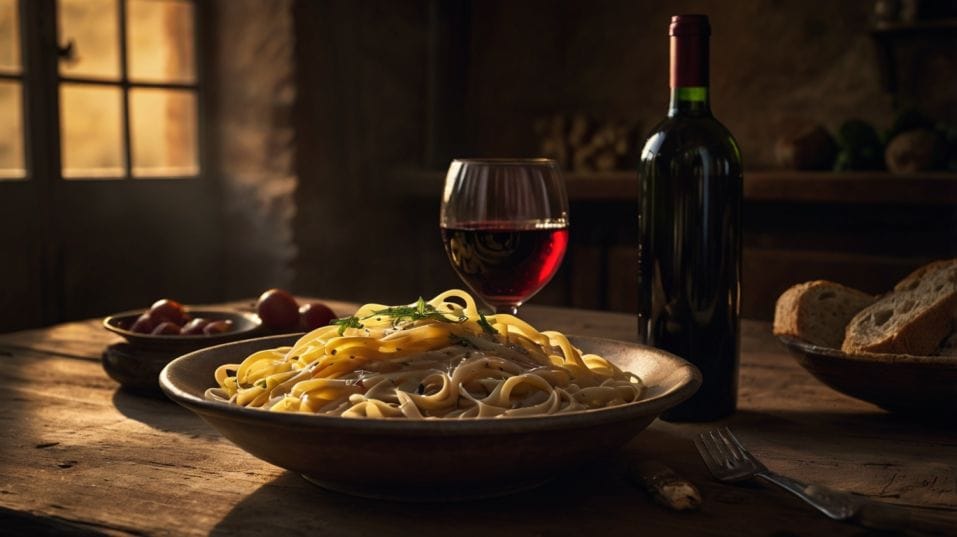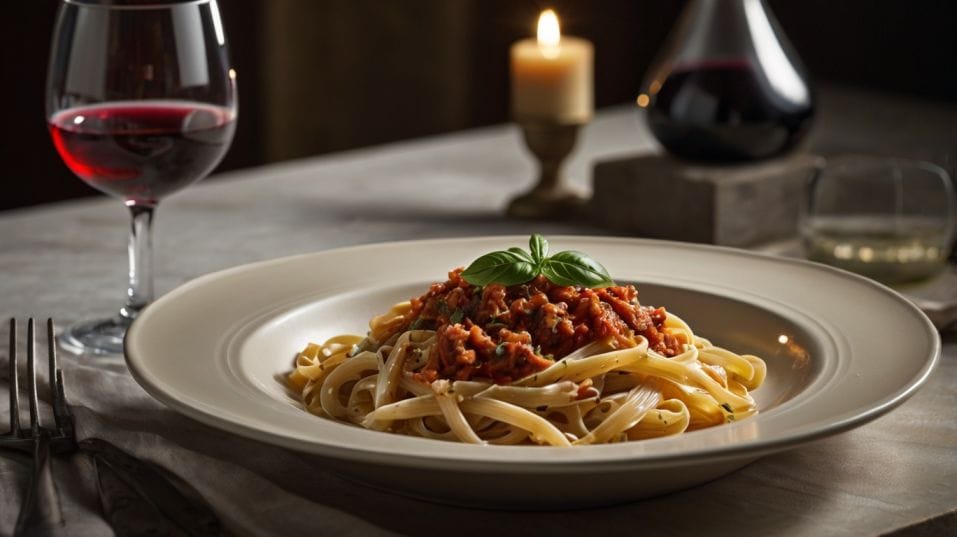Best Wines for Rich Pasta Dishes
Learn how to pair wine with rich pasta dishes. Discover wines that cut through cream, lift umami, and sharpen your tasting skills fast.

What if your next bowl of pasta could actually teach you about wine? Rich sauces—creamy, meaty, or deeply savory—are more than comfort food. They’re a fast track to understanding how wine works with texture and intensity.
The right pairing doesn’t just taste better—it sharpens your palate. Forget guessing. Learn to choose wine that elevates the dish and reveals what balance really means in a glass.
Why Rich Pasta Deserves More Than a Safe Red
Cream-based sauces, long-simmered ragùs, truffle oil, egg yolks, aged cheese—these aren’t delicate dishes. They saturate your palate, layer fat with salt, and create a rich mouthfeel that lingers.
That richness needs contrast, lift, and depth from your wine. Without it, both the pasta and the wine fall flat.
The instinct is often to grab a bold red—something familiar, maybe even a little flashy. But not all rich pastas want or need big tannins.
Some need acidity. Others need minerality, savory notes, or even oxidative depth. Once you understand that you're matching texture and intensity, not just color or reputation, the choices get much smarter.
Acidity: The Backbone of a Good Pairing
Acidity is your best tool when it comes to rich food. It cleans the palate, cuts through fat, and keeps each bite tasting fresh. In wine terms, this means avoiding overly ripe, fruit-forward bottles with high alcohol and low acidity.
They may seem luxurious, but they tend to muddy the flavors of both food and wine when paired with creamy or dense dishes. Look for wines from cooler climates—places where grapes ripen slowly and retain freshness.
Italian reds from regions like Piedmont or Tuscany, white wines from northern Spain or the Loire Valley, and Alpine varietals from Austria or Alto Adige all offer the kind of acidity that can bring rich food into balance.

Red Wines That Play Well with Depth
When you’re dealing with hearty ragùs, slow-braised meats, or earthy mushroom sauces, red wine still leads the way—but it needs to be the right kind.
Sangiovese
Especially in a well-made Chianti Classico or Rosso di Montalcino, offers a balance of bright acidity, dusty tannins, and savory cherry notes that work beautifully with tomato-based or meaty sauces. It doesn’t dominate—it partners.
Barbera
Brings high acidity with softer tannins, making it especially versatile with both tomato-forward and cream-enhanced sauces. It’s a great choice when your pasta has both brightness and richness, like a tomato-cream or sausage-based dish.
Nebbiolo
Found in Barolo or Barbaresco, is more structured.
Its tannins can be firm, but when paired with deeply savory sauces—think short rib ragù, porcini risotto-style pasta, or truffle-laced pappardelle—it creates one of the most dynamic pairings you can experience.
Aglianico
From southern Italy, comes into play for ultra-rich sauces like oxtail ragù or game-based pici. Its dark fruit and sturdy tannins offer gravity without clashing, especially if the sauce is long-cooked and deeply seasoned.
White Wines With Texture and Power
Rich pasta doesn’t always call for red. In fact, some of the most surprising, complex pairings come from white wines with body, depth, and a bit of age.
Chardonnay
Particularly from Burgundy or well-made New World producers using restraint, offers that elusive mix of creamy texture and cutting acidity.
It's especially powerful with dishes like fettuccine Alfredo, lobster ravioli, or pasta with a butter-based sauce and seafood. Choose versions with less new oak and more mineral drive.
Chenin Blanc
Especially from the Loire Valley, can be stunning with creamy sauces or carbonara. Its natural acidity and often slightly waxy texture let it wrap around the richness without disappearing.
Bonus: its layered aromatics—quince, lanolin, white flowers—add complexity where the dish might be more savory than aromatic.
Friulano, Verdicchio, and Vermentino
All offer slightly saline, herbal edges that do incredibly well with pasta dishes that lean into cheese, seafood, or truffles. They’re not flashy wines, but they’re serious—and they won’t get lost on a table with intense food.
Orange Wines
Or extended skin-contact whites. Their tannic grip and oxidative complexity can be fantastic with aged cheese sauces or funky, rich dishes like gorgonzola pasta or duck liver ravioli.
These wines behave almost like reds in terms of structure, but keep the brightness and spice of a white.
Sparkling and Rosé: Underrated but Effective
It’s easy to overlook sparkling wine, but high-acid, bone-dry styles (like a good Franciacorta or grower Champagne) can slice through richness like few still wines can.
These work beautifully with creamy pastas, fried garnishes, or anything eggy like carbonara. Texture matters here—look for wines with fine mousse and minimal dosage.
Rosé, particularly from southern France or northern Italy, offers just enough red fruit and structure to handle richer pastas—especially those with seafood or roasted vegetables.
Think rosé with lobster ravioli in tomato-cream sauce, or a Bandol rosé with saffron-infused pasta and grilled shrimp.
Pairing by Pasta Type vs. Sauce
While the sauce is often the dominant factor in pairing, the pasta itself adds another layer. A silky tagliatelle calls for a different feel than a dense baked ziti or al dente rigatoni.
Long, Flat Noodles
Like fettuccine, tagliatelle, or pappardelle hold sauces closely and tend to enhance creaminess and texture. Here, wines with elegance and length shine.
You don’t want anything too blocky or tannic. Instead, look for wines with linear structure and savory detail.
Tube Pastas
Like rigatoni, penne, or paccheri tend to emphasize chunkier sauces—meat, vegetables, or beans—and invite wines with grip and heft. Tannin and earthy complexity play better here.
Stuffed Pastas
From ravioli to agnolotti—often carry subtle, rich fillings like cheese, meat, or vegetables with butter-based sauces.
These are a chance to let the wine echo the filling. But don’t overthink it—focus on the sauce’s weight and let the filling be the detail, not the driver.
Final Thoughts
The more you explore wine with rich pasta, the more you understand what makes a wine work. It’s not about matching flavors—it’s about balancing weight, structure, and freshness.
Acid is your anchor. Texture is your bridge. Complexity—not just boldness—is what lets wine elevate the dish instead of drowning it.
So next time you make something indulgent—creamy, meaty, deeply savory—don't just reach for a familiar bottle. Think about what the dish feels like, and choose a wine that complements that.
Try a structured white with your Alfredo. Test a lean red with your carbonara. Explore an orange wine with a funky cheese sauce.
Then, taste it all again. Not to judge it, but to understand it. That’s how you build a palate that’s not just confident, but curious. Start tonight.
Open something new. Taste with intention. And trust that every good pairing teaches you something worth remembering.




